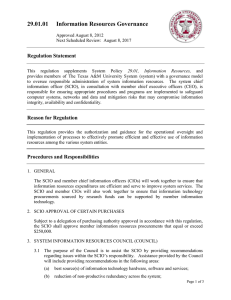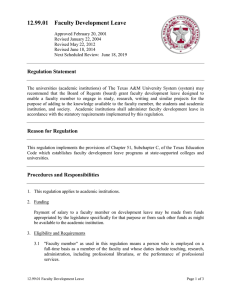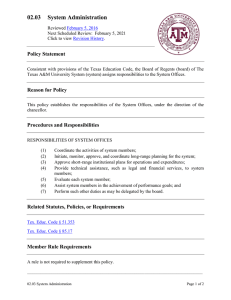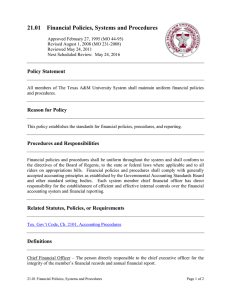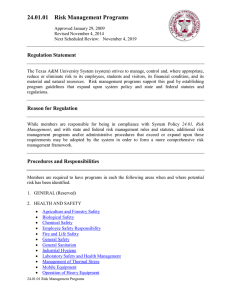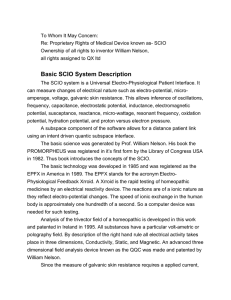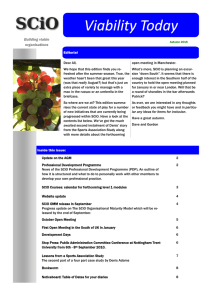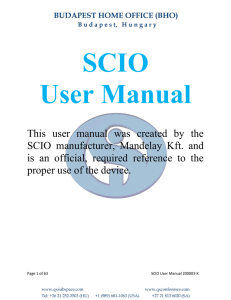29.01 Information Resources
advertisement
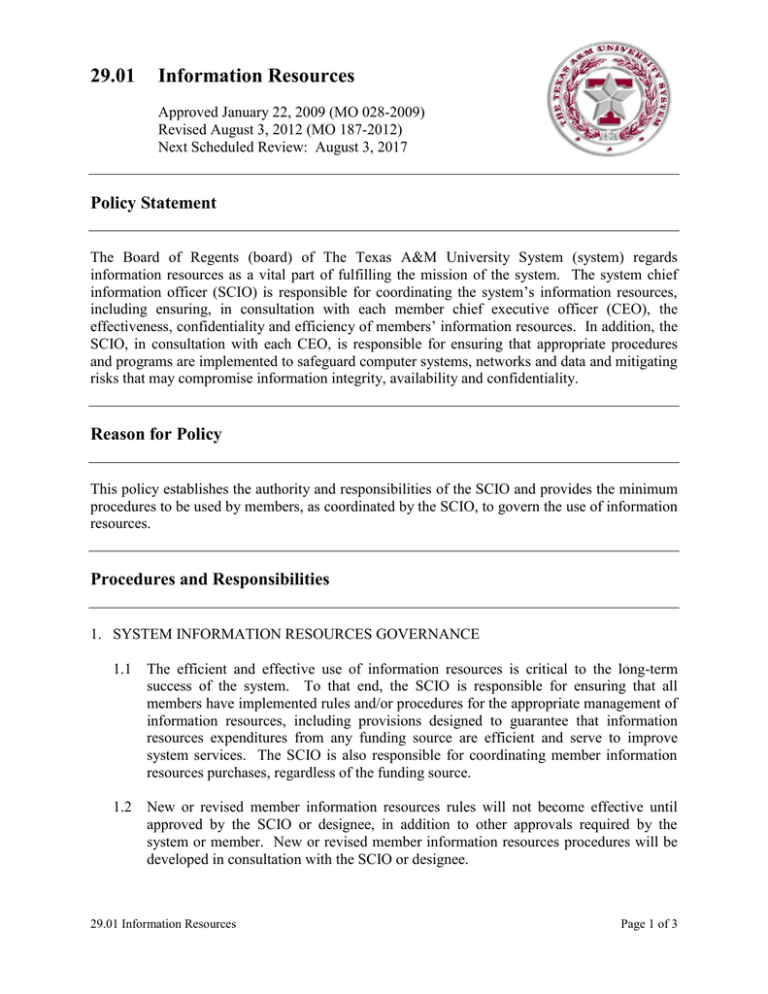
29.01 Information Resources Approved January 22, 2009 (MO 028-2009) Revised August 3, 2012 (MO 187-2012) Next Scheduled Review: August 3, 2017 Policy Statement The Board of Regents (board) of The Texas A&M University System (system) regards information resources as a vital part of fulfilling the mission of the system. The system chief information officer (SCIO) is responsible for coordinating the system’s information resources, including ensuring, in consultation with each member chief executive officer (CEO), the effectiveness, confidentiality and efficiency of members’ information resources. In addition, the SCIO, in consultation with each CEO, is responsible for ensuring that appropriate procedures and programs are implemented to safeguard computer systems, networks and data and mitigating risks that may compromise information integrity, availability and confidentiality. Reason for Policy This policy establishes the authority and responsibilities of the SCIO and provides the minimum procedures to be used by members, as coordinated by the SCIO, to govern the use of information resources. Procedures and Responsibilities 1. SYSTEM INFORMATION RESOURCES GOVERNANCE 1.1 The efficient and effective use of information resources is critical to the long-term success of the system. To that end, the SCIO is responsible for ensuring that all members have implemented rules and/or procedures for the appropriate management of information resources, including provisions designed to guarantee that information resources expenditures from any funding source are efficient and serve to improve system services. The SCIO is also responsible for coordinating member information resources purchases, regardless of the funding source. 1.2 New or revised member information resources rules will not become effective until approved by the SCIO or designee, in addition to other approvals required by the system or member. New or revised member information resources procedures will be developed in consultation with the SCIO or designee. 29.01 Information Resources Page 1 of 3 1.3 The SCIO, with the chancellor’s approval, shall establish an information resources governance structure at the system level that accomplishes the following: (a) identifies and coordinates the best source(s) of information technology hardware, software and services; (b) reduces non-productive redundancy across the system; (c) when in the best interest of the system, and strategic objectives of the member(s), consolidates resources including networks, hardware, systems and applications; (d) improves the security of the system’s technology infrastructure; and (e) determines appropriate thresholds for delegating purchasing authority to member CEOs. 2. USE OF SYSTEM INFORMATION RESOURCES 2.1 Each user is responsible for using system information resources in accordance with the guidelines established by the Texas Department of Information Resources, the Texas Ethics Commission and System Policy 07.01, Ethics. Accordingly, each user should: (a) use information resources for officially authorized business purposes, with exception for incidental use as allowed in accordance with System Policy 33.04, Use of System Resources; (b) promptly disclose fraud, waste or abuse in accordance with System Policy 21.04, Control of Fraud, Waste and Abuse; (c) adhere to all laws, regulations and policies that refer to the use of information resources; and (d) endeavor to avoid any actions that would create the appearance that the user is violating the law or the system’s ethical standards. 2.2 Privacy policies are mechanisms used to establish the responsibilities and limits for system administrators and users in providing privacy in information resources. There is no expectation of privacy when using system information resources beyond that which is expressly provided by applicable privacy laws. Information created, stored or transmitted on system information resources may be subject to disclosure under the Texas Public Information Act or through legal or administrative proceedings. While the system does not routinely monitor individual usage of system information resources, members have the right to examine information created, stored or transmitted on system information resources for general business purposes, including but not limited to the normal operation and maintenance of such resources. 2.3 In accordance with Section 1.2, each member will develop and implement rules and/or procedures to ensure compliance with applicable Texas Department of Information Resources’ rules; for example, Texas Administrative Code, Title 1, Ch. 202, Information Security Standards, Ch. 206, State Web Sites, and Ch. 213, Electronic and Information Resources. 29.01 Information Resources Page 2 of 3 Related Statutes, Policies, or Requirements Tex. Educ. Code § 51.9335, Acquisition of Goods and Services Tex. Gov’t Code Ch. 2054, Information Resources 1 Tex. Admin. Code Ch. 202, Information Security Standards 1 Tex. Admin. Code Ch. 206, State Websites 1 Tex. Admin. Code Ch. 211, Information Resources Managers 1 Tex. Admin. Code Ch. 213, Electronic and Information Resources 1 Tex. Admin. Code Ch. 216, Project Management Practices System Policy 10.02, Control of Fraud, Waste and Abuse System Regulation 29.01.02, Use of Licensed Commercial Software System Policy 33.04, Use of System Resources System Regulation 33.04.02, Use of Telecommunication Services Definitions Information resources – the procedures, computer equipment, computing facilities, software and data which are purchased, designed, built, operated and maintained to collect, record, process, store, retrieve, display, report and transmit information. Member Rule Requirements A rule is required to supplement this policy. See Sections 1.1, 1.2 and 2.3. Contact Office Office of the System Chief Information Officer (979) 458-6450 29.01 Information Resources Page 3 of 3
